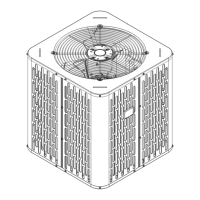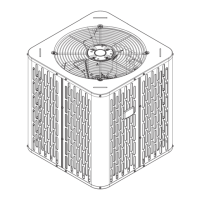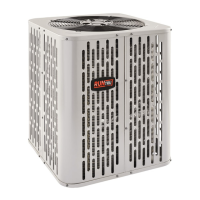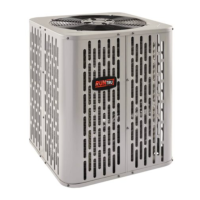
Do you have a question about the Trane A4HP4 and is the answer not in the manual?
| Model | A4HP4 |
|---|---|
| Type | Heat Pump |
| Refrigerant | R-410A |
| Stages | Single-stage |
| Voltage | 208/230V |
| Phase | 1 |
| SEER Rating | 14 |
| HSPF Rating | 8.2 |
| Compressor Type | Scroll |
| Sound Level (Outdoor Unit) | 76 dB |
Safety precautions for live electrical components during installation and service.
Disconnect power before servicing to prevent severe injury or death.
Avoid touching hot compressor domes to prevent burns.
Follow proper procedures to avoid injury or equipment damage from refrigerant.
Ensure leak tests are negative when using mechanical connections for brazing.
Units use R-410A refrigerant, requiring approved service equipment and procedures.
Caution when opening liquid line service valve to prevent abrupt release of charge.
Avoid touching hot surfaces to prevent burns or property damage.
Ensure proper grounding for electrical safety and to prevent damage.
Product may expose to chemicals known to cause cancer or birth defects.
Extreme caution needed when opening service valves to prevent charge release.
Provides dimensions and weight specifications for different models.
Identifies locations of service valves for connections and measurements.
Specifies maximum total length and vertical change for refrigerant lines.
Recommendations for optimal unit placement to ensure airflow and prevent issues.
Precautions for units in areas with snow and freezing temperatures.
Step to check for and report any damage to the unit before installation.
Guidelines for installing the unit on a support pad, including levelness and drainage.
Table detailing line sizes and service valve connection sizes for various models.
Information on factory-charged units and verifying system charge.
Instructions to determine required line length and lift for charging calculations.
Importance of insulating the vapor line and preventing metal-to-metal contact.
Precautions for reusing existing refrigerant lines and coils.
Guidelines for routing refrigerant lines to prevent noise and comply with codes.
Step-by-step instructions for brazing refrigerant lines to service valves and filter driers.
Procedure to pressurize lines with nitrogen and check for leaks using soapy solution.
Steps to evacuate the system to a specific micron level.
Procedure for opening the gas service valve after leak check and evacuation.
Procedure for safely opening the liquid service valve with caution.
Table defining maximum wire lengths for low voltage connections.
Diagrams illustrating low voltage wiring for heat pump and AC systems.
Explains defrost control operation, termination, and jumper settings.
Notes on high voltage power supply requirements and compliance with codes.
Requirement to install a separate disconnect switch at the outdoor unit.
Grounding requirements for the outdoor unit per national and local codes.
Step-by-step procedure for starting the system after installation.
Instructions for taking temperature measurements for system charging.
Method for charging systems using TXV/EEV based on subcooling.
Charts and steps for determining subcooling corrections based on line length and lift.
Requirement to stabilize the system for 20 minutes before measurements.
Measuring liquid line temperature and pressure for charging.
Determining liquid gage pressure using subcooling and temperature charts.
Chart to determine liquid gage pressure based on final subcooling and liquid temperature.
Procedure for adding or recovering refrigerant to match chart values.
Steps to stabilize the system and remove gauges after charging.
Referencing pressure curves to verify system performance.
Table for determining superheat for systems with fixed orifice metering devices.
Recording system pressures and temperatures after charging.
Method for determining additional charge for longer line sets in heating mode.
Procedure for calculating refrigerant charge using the weigh-in method.
Stabilizing the system after charge adjustment.
Checking liquid line temp and pressure for subcooling in heating.
Adding charge if target subcooling is not met.
Returning for adjustment in cooling mode when ambient is above 55°F.
Final inspection and checkout list for proper operation and performance.
Explains how the demand defrost control measures temperatures and determines defrost needs.
How fault conditions are indicated by the Fault LED on the control board.
Identifies test pins (TEST_COMMON, FRC_DFT) on the defrost control board.
Checks for normal operation including status LED, voltage, and defrost initiation.
Procedure to unplug and measure sensor resistance for testing.
Table relating temperature to thermistor resistance for defrost control.
Quick specifications for demand defrost features and parameters.
Lists LED fault codes, descriptions, and control behaviors.
Continues listing LED fault codes and their corresponding defrost control behavior.
Explains adaptive limp modes, lockout periods, and fault clearing conditions.
Flowchart to diagnose why the compressor fails to start.
Flowchart for troubleshooting TXV and heating mode issues.
Flowchart to diagnose compressor not running issues, checking voltage and components.
Wiring diagrams for specific heat pump models.
Wiring diagrams for the 42D heat pump models.
Wiring diagrams for the 48D and 60D heat pump models.
Explains symbols, wire colors, and terminal designations used in wiring diagrams.
Safety warning about disconnecting power before servicing.
Warning for Canadian installations regarding voltage limits.
Warning to use only copper conductors for unit terminals.
Instructions for checking cooling performance using pressure curves.
Pressure charts for the A4HP4017D1 model in cooling and heating modes.
Pressure charts for the A4HP4018D1 model in cooling and heating modes.
Pressure charts for the A4HP4024D1 model in cooling and heating modes.
Pressure charts for the A4HP4030D1 model in cooling and heating modes.
Pressure charts for the A4HP4036A1 model in cooling and heating modes.
Pressure charts for the A4HP4042A1 model in cooling and heating modes.
Pressure charts for the A4HP4048A1 model in cooling and heating modes.
Pressure charts for the A4HP4060A1 model in cooling and heating modes.
Diagram illustrating the refrigerant flow during the heating cycle.
Diagram illustrating the refrigerant flow during the cooling cycle.












